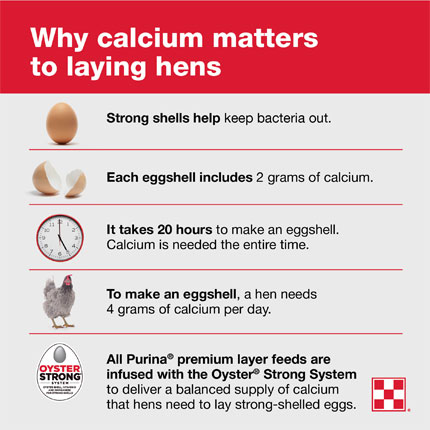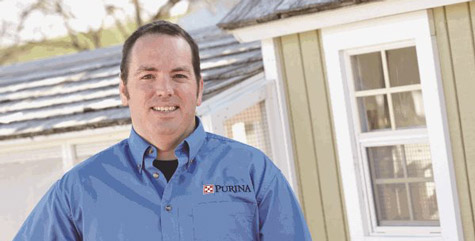
Safe Eggs Start with Strong Shells
Flock Management : Layer Nutrition
Flock Management : Egg Production
Strong shells matter because they impact egg safety for your family. Strong eggshells are better able to keep bacteria out. Get strong eggs with Oyster Strong® System, exclusively in Purina® premium and organic layer feeds.
Sunny side up, over easy or hard boiled? Think about the last time you cooked eggs. Did the shell break in a crisp, perfect line or was the crack more of a crumble and shatter? If it was the first, your eggshells are strong and protective. If it was the second, your backyard hens could use a calcium boost.
Strong shells are an important part of egg safety. When we raise backyard chickens, we are ultimately producing a consumable food product: farm fresh eggs. As flock raisers, it’s our responsibility to produce eggs as safely as we can. One way to help keep eggs safe is by feeding hens for shell strength. Strong shells help keep bacteria out and eggs protected.
 Let’s start by looking at the shell under a microscope. A strong eggshell is about 0.3 millimeters thick and has between 7,000 and 17,000 tiny pores1. These pores work to allow oxygen, carbon dioxide and moisture to pass through, but to keep bacteria out.
Let’s start by looking at the shell under a microscope. A strong eggshell is about 0.3 millimeters thick and has between 7,000 and 17,000 tiny pores1. These pores work to allow oxygen, carbon dioxide and moisture to pass through, but to keep bacteria out.
Eggshells with larger pores or thinner shells have less protective power. A strong shell can help deflect bad bacteria, while bacteria can fit through the larger pores of a weak shell.
The shell is then covered by a thin coating called the bloom, or cuticle, for added protection. Just inside the shell, the inner and outer membranes provide yet another layer of defense.
These protective shields work together to keep the contents of an egg safe and healthy. However, none of these barriers are effective unless you start with a strong eggshell; it’s the egg’s first line of defense.
All Purina® premium layer feeds are infused with the Oyster Strong® System to ensure your laying hens achieve a balanced supply of calcium through a blend of oyster shell, vitamin D and manganese. These three ingredients work together to help your chickens produce strong-shelled, delicious eggs each day.
Hens that lack proper calcium levels typically produce soft or brittle eggshells. Sometimes an improper calcium balance can cause hens to pull calcium from their bones to produce eggshells, weakening their overall skeletal structure.
The Oyster Strong® System utilizes larger particles of oyster shell to provide a slow and steady release of calcium during the night when hens are forming eggshells. Vitamin D is like the taxi that gets the calcium into your hen’s bloodstream where it’s needed, while manganese helps strengthen and create the structure of the egg. The Oyster Strong® System brings all three nutrients together to help your hens make strong, healthy eggshells.
Choose a layer feed with the Purina® Oyster Strong® System to help your hens lay strong and stay strong.
Which layer feed Oyster Strong® System is right for your flock?
Ready to level up with Oyster Strong®? Sign-up for the Feed Greatness® Challenge.
Sunny side up, over easy or hard boiled? Think about the last time you cooked eggs. Did the shell break in a crisp, perfect line or was the crack more of a crumble and shatter? If it was the first, your eggshells are strong and protective. If it was the second, your backyard hens could use a calcium boost.
Strong shells are an important part of egg safety. When we raise backyard chickens, we are ultimately producing a consumable food product: farm fresh eggs. As flock raisers, it’s our responsibility to produce eggs as safely as we can. One way to help keep eggs safe is by feeding hens for shell strength. Strong shells help keep bacteria out and eggs protected.
Strong eggshells keep bacteria out
Shell strength is determined by two primary factors: thickness and pore size. Let’s start by looking at the shell under a microscope. A strong eggshell is about 0.3 millimeters thick and has between 7,000 and 17,000 tiny pores1. These pores work to allow oxygen, carbon dioxide and moisture to pass through, but to keep bacteria out.
Let’s start by looking at the shell under a microscope. A strong eggshell is about 0.3 millimeters thick and has between 7,000 and 17,000 tiny pores1. These pores work to allow oxygen, carbon dioxide and moisture to pass through, but to keep bacteria out.Eggshells with larger pores or thinner shells have less protective power. A strong shell can help deflect bad bacteria, while bacteria can fit through the larger pores of a weak shell.
The shell is then covered by a thin coating called the bloom, or cuticle, for added protection. Just inside the shell, the inner and outer membranes provide yet another layer of defense.
These protective shields work together to keep the contents of an egg safe and healthy. However, none of these barriers are effective unless you start with a strong eggshell; it’s the egg’s first line of defense.
How to get strong eggshells
Realizing the importance of shell strength, many researchers have considered the connection between chicken layer feed and shell formation. The major player in the equation is calcium. Once laid, an eggshell includes 2 grams of calcium. To get this level and still maintain strong bones, a hen requires 4 grams of calcium – all of which must come from her layer feed.All Purina® premium layer feeds are infused with the Oyster Strong® System to ensure your laying hens achieve a balanced supply of calcium through a blend of oyster shell, vitamin D and manganese. These three ingredients work together to help your chickens produce strong-shelled, delicious eggs each day.
Hens that lack proper calcium levels typically produce soft or brittle eggshells. Sometimes an improper calcium balance can cause hens to pull calcium from their bones to produce eggshells, weakening their overall skeletal structure.
The Oyster Strong® System utilizes larger particles of oyster shell to provide a slow and steady release of calcium during the night when hens are forming eggshells. Vitamin D is like the taxi that gets the calcium into your hen’s bloodstream where it’s needed, while manganese helps strengthen and create the structure of the egg. The Oyster Strong® System brings all three nutrients together to help your hens make strong, healthy eggshells.
Choose a layer feed with the Purina® Oyster Strong® System to help your hens lay strong and stay strong.
Which layer feed Oyster Strong® System is right for your flock?
- Purina® Farm to Flock™ 18% Layer Supports gut health
- Purina® Layena® pellets or crumbles Our most popular layer feeds
- Purina® Layena® Omega-3 Includes added omega-3 fatty acids for your health
- Purina® Layena® High Protein Includes 19% protein and black fly soldier fly larvae
- Purina® Organic Layer Feed Certified USDA Organic
Ready to level up with Oyster Strong®? Sign-up for the Feed Greatness® Challenge.
1 “How thick is an eggshell? “University of California-Santa Barbara. http://www.eggnutritioncenter.org/blog/fun-fact-friday-an-egg-has-7000-17000-tiny-pores-on-its-shell/. 11 September 2017.



